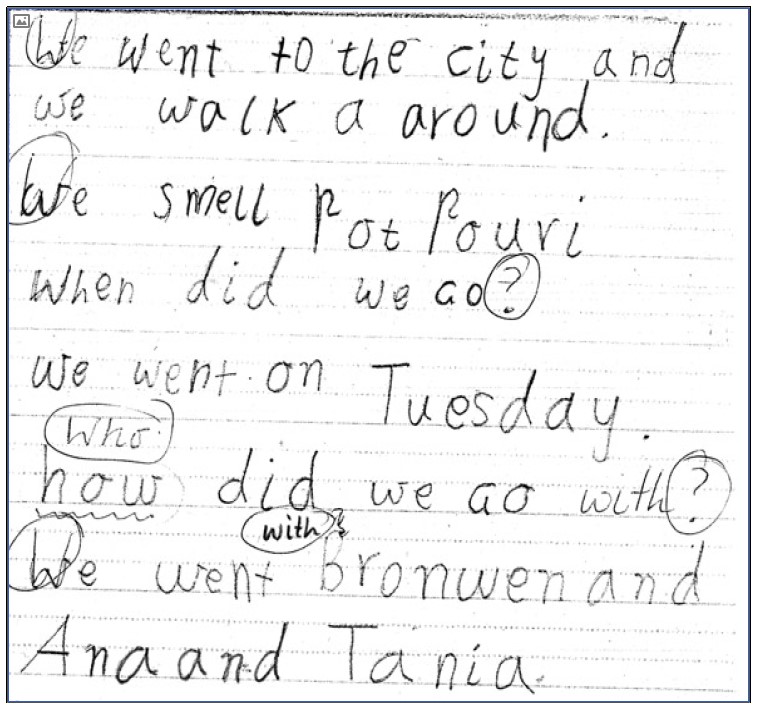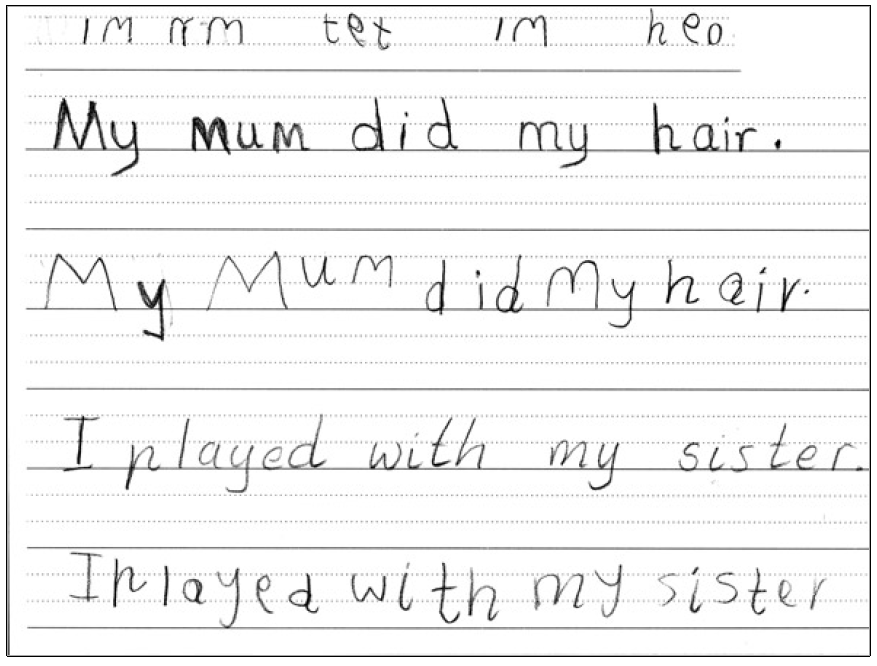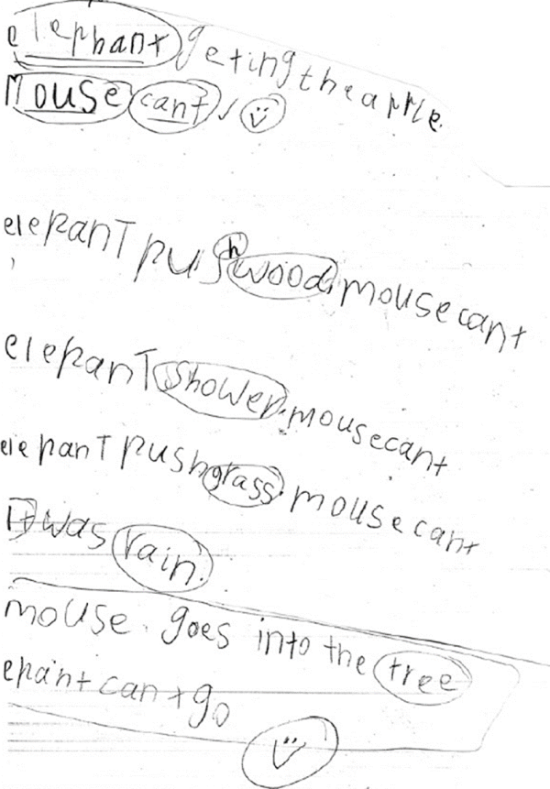The student work samples on this page are also available to download:
BL Writing proficiency levels and Achievement Standard
The students' performance in these tasks suggest that they are working within the range of Level BL in Writing. The assessing teacher will need to consider a range of student samples in order to determine whether each student is at the beginning of BL, consolidating BL or at the BL standard in Writing.
At beginning Level BL students:
- are new to English and new to literacy
- may be reluctant to participate in writing activities and may not understand their purpose
and/or
- may have little or no experience of formal learning and do not have literacy strategies already acquired through developing literacy in a home language
and/or
- may have difficulty with the mechanics of writing, for example, they might not be used to holding pencils or crayons and making 'marks' on the page, depending on their prior experiences
- will be able to draw on general learning skills and strategies that they have used to function effectively in their home communities, for example observing, memorising, classifying.
At consolidating Level BL students:
- use drawing as a means of expression
- will show improvements in their ability to form letters and produce copied text
- copy writing from other sources, for example environmental print, other students, the teacher's model
- will observe shared writing tasks, watching as the teacher writes and will begin to contribute as much as their limited English allows
- talk about their writing and pictures, drawing on their oral English language and may use their home language with same language peers or bilingual teacher
- may exhibit limited concentration during shared writing tasks.
At
Level BL Achievement Standard students:
- communicate their ideas and experiences simply through written, drawn, copied or dictated texts
- contribute to whole-class or small-group shared writing activities
- demonstrate an early awareness that written texts in English are presented according to certain conventions, which change according to context and purpose
- write simple sequenced descriptions, recounts and procedures, following models
- write or draw for specific audiences.
- produce writing that reflects their oral structures
- link ideas using common conjunctions and show awareness of the uses of basic punctuation
- demonstrate knowledge of some English letter–sound relationships and spelling of high-frequency words
- demonstrate knowledge of some English letter–sound relationships and spelling of high-frequency words
- show evidence of some planning
- model their writing on shared writing activities and published texts
- use some basic strategies, such as copying words or phrases from lists, using images and asking how to write a word
- begin to form letters and place text appropriately
- copy texts using computer software applications.
Informative text - City excursion
Student information
This student is 11 years old and was born in Sudan. The student speaks Dinka and a little Arabic. They have had very limited schooling in Arabic (possibly one year) before starting at an English language school. The student is not literate in any language. The student had been at the language school for approximately ten months when they wrote this recount. The student is in Year 4.
Task
The student worked independently to write a recount about a city excursion. The student used the 'have-a-go' strategy to spell some unknown words. There were questions words such as
who and
what, and some vocabulary such as
potpourri written on the board. The teacher had worked with the student to edit the sentences and spelling.

Text
We went to the city and we walk a around.
We smell potpourri
When did we Go?
we went on Tuesday.
how did we Go with?
We went Bronwen and Ana and Tania.
This sample of student work demonstrates that the student can:
- Write or dictate in sentences or phrases that match oral sentence structures
(VCEALL227)
- Write very short, simple texts
(VCEALL228)
- Write some familiar words and complete simple, repetitive modelled sentences in writing
(VCEALC217)
- Apply common conventions when copying or writing texts
(VCEALL236)
- Copy words, phrases or sentences accurately and carefully
(VCEALC216)
Possible next steps for this student's learning
- Sequencing the events of the excursion using photographs to support writing an extended text
(VCEALC215)
- Editing the writing for simple past tense verbs
(VCEALL231)
- Typing out the writing and publishing the final version of the writing
(VCEALA222)(VCEALL239)
- Using simple punctuation appropriately such as full stops and capital letters
(VCEALL238)
Pathways and transitions considerations
A Year 4 student working within the range of Level BL in any one language mode is not ready to transition to the English curriculum regardless of their proficiency in the other two language modes. This student will continue on Pathway B of the EAL curriculum in all language modes.
Informative text - Family activities
Student information
This student is 11 years old and was born in Sudan. The student speaks Dinka and a little Arabic. They have had very limited schooling in Arabic (possibly one year) before starting at an English language school. The student is not literate in any language. The student had been at the language school for approximately five months when they wrote this recount. The student is in Year 4.
Task
The students were asked to write about things that they do with their family. This text was written by the student approximately six months into their learning at the English language school. The student first attempted to write a sentence independently. Then they copied the teacher's writing. The last sentence was dictated to the teacher, then copied.

Text
IM nM tet IM heo
(My mum did my hair)
My mum did my hair.
I played with my sister.
I played with my sister
This sample of student work demonstrates that the student can:
- Use drawings, symbols, strings of letters and some words in own written work
(VCEALC214)
- Express imaginative or personal ideas in simple forms of writing
(VCEALC218)
- Use basic verbs
(VCEALL231)
- Apply common conventions when copying or writing texts
(VCEALL236)
- Copy words, phrases or sentences accurately and carefully
(VCEALC216)
- Copy basic punctuation as part of writing work
(VCEALL238)
- Draw pictures to communicate activities or events and orally dictate sentences for the teacher to record
(VCEALC215) *final sentence is dictated to the teacher and then copied correctly by the student.
Possible next steps for this student's learning
- Continuing to practise letter formation
(VCEALL236)
- Learning and practising writing formulaic words and sentences to build up vocabulary and grammar knowledge
(VCEALC217)
- Developing basic independent writing strategies, for example, copying words from familiar vocabulary lists
(VCEALA226)
- Using initial letter and sound to represent words such as
b for
book(VCEALL237)
Pathways and transitions considerations
A Year 4 student working within the range of Level BL in any one language mode is not ready to transition to the English curriculum regardless of their proficiency in the other two language modes. This student will continue on Pathway B of the EAL curriculum in all language modes.
Imaginative text – An elephant and a mouse
Student information
The student is about 10 to 11 years old and in Year 4. They were born in Sudan and speak Dinka and a little Arabic as their home language. The student had approximately one year of schooling in Arabic before starting at an English language school. They are not literate in any language.
Task
The teacher read a story to the students. Then the students used a series of pictures to write sentences to retell the story. The student copied text from the book (underlined words) and asked for assistance to spell some words (circled). Otherwise the student worked independently.
The analysis is based on the student’s writing before correction.

Text
elephant geting the apple
Mouse cant
elepanT pus wood, mouse cant
elephant Shower. mousecant
elepanT pushgrass. mouse cant
It was rain.
mouse goes into the tree
epant cantgo
This sample of student work demonstrates that the student can:
- Use drawings, symbols, strings of letters and some words in own written work (VCEALC214)
- Copy words, phrases or sentences accurately and carefully (VCEALC216)
- Write some familiar words and complete simple, repetitive modelled sentences in writing (VCEALC217)
- Create basic texts, with support and modelling (VCEAL220)
- Write or dictate in sentences or phrases that match oral sentence structures (VCEALL227)
- Write very short, simple texts (VCEALL228)
- Sequence a small number of ideas simply (VCEALL229)
- Use basic verbs (VCEALL231)
- Use topic-specific vocabulary encountered in classroom activities (VCEALL235)
- Apply common conventions when copying or writing texts (VCEALL236)
- Spell a number of high-frequency words accurately (VCEALL237)
Possible next steps for this student's learning
- Using conjunctions to join two sentences together such as but (VCEALL233)
- Editing writing to include capital letters and full stops appropriately (VCEALL238)
- Unjumbling and reordering cut-up sentences (VCEALL229)
- Reading own sentences and matching them with pictures in the book (VCEALL227)
Pathways and transitions considerations
A Year 4 student working within the range of Level BL in any one language mode is not ready to transition to the English curriculum regardless of their proficiency in the other two language modes. This student will continue on Pathway B of the EAL curriculum in all language modes.
Related pages
Student work samples: Level BL Speaking and Listening
Student work samples: Level BL Reading and Viewing
Student work samples: Level B1 Writing